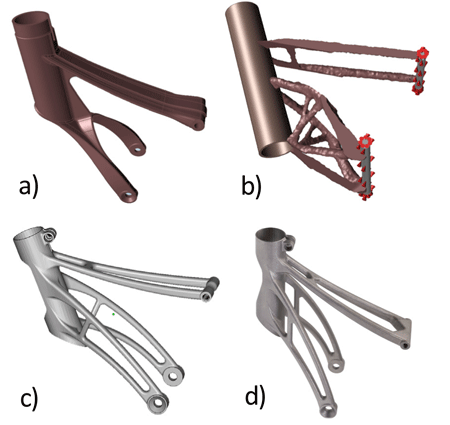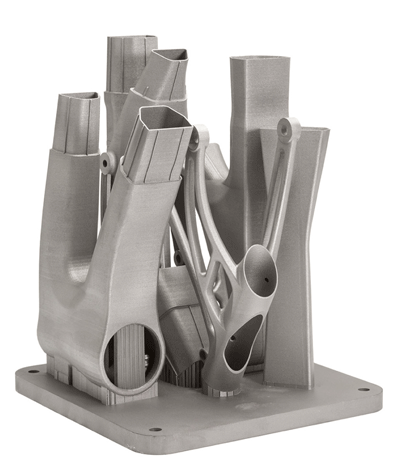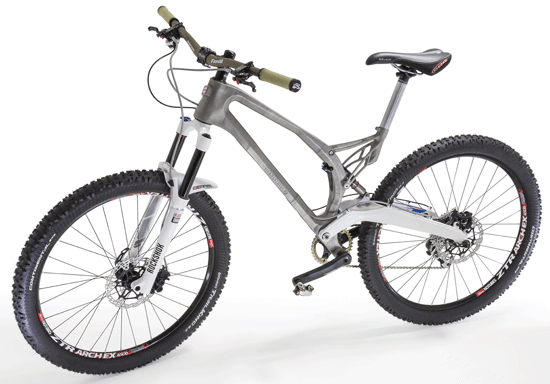World’s first Additive Manufactured metal bike frame
March 19, 2014
Renishaw, a UK manufacturer of metal-based Additive Manufacturing (AM) systems, has collaborated with a leading British bicycle design and manufacturing company to create what they claim to be is the world’s first AM metal bike frame. Empire Cycles designed the mountain bike to take advantage of Renishaw’s AM technology, allowing them to create a titanium bike frame that would be both strong and light.
The frame, which is around 33% lighter than the original, has been Additively Manufactured in titanium alloy in sections and bonded together. By working together, Renishaw and Empire Cycles optimised the bicycle design for AM, eliminating many of the downward facing surfaces that would otherwise have needed wasteful support structures.

The process of optimising the design for Additive Manufacturing included the following steps: a) CAD model of seat post designed for aluminium alloy casting b) Topological optimisation using Altair’s solidThinking Inspire® 9.5 software c) Re-designed by Empire Cycles using the optimised CAD model as a template d) Produced in titanium alloy on a Renishaw AM250 laser melting system
The design process incorporated the use of topological optimisation software to determine the logical place for material. Material is removed from areas of low stress until a design optimised for load bearing is finalised. The resulting model is both light and strong. The historical challenge in manufacturing these shapes can now be overcome with Additive Manufacturing, enabling physical 3D models to be realised.

The entire bike frame was arranged in sections with the seat post
bracket on one build plate and fabricated in one go
The frame is manufactured from titanium alloy which has a high Ultimate Tensile Strength (UTS) of more than 900 MPa when processed using Additive Manufacturing. Near perfect densities of greater than 99.7% are also achieved when processed via AM, which is better than casting alternatives.
Titanium alloys are more dense than aluminium alloys, with relative densities of around 4 g/cm3 and 3 g/cm3 respectively. Therefore, the only way to make a titanium alloy version of a part lighter than its aluminium alloy counterpart is to significantly alter the design to remove any material not contributing to the overall strength of the part.
The original bike frame weighs in at 2100 g, redesigned to make use of Additive Manufacturing the weight dropped to 1400 g, a 33% weight saving. The original aluminium alloy seat post bracket is 360 g and the hollow titanium version is 200 g, a weight saving of 44%. With further analysis and testing weight could be reduced further stated Renishaw. There are lighter carbon fibre bikes available, but Chris Williams, Managing Director at Empire Cycles, stated, “The durability of carbon fibre can’t compare to a metal bike, they are great for road bikes, but when you start chucking yourself down a mountain you risk damaging the frame. I over-engineer my bikes to ensure there are no warranty claims”.
The project’s aim is to produce a fully functioning bicycle, so the seat post bracket was tested using the mountain bike standard EN 14766. It withstood 50 000 cycles of 1 200 N and testing continued to six times the standard without failure. Testing of the completed frame will continue, both in the laboratory and on the mountainside using portable sensors in partnership with Swansea University.
Useful links
To submit news and articles for publication on Metal Additive Manufacturing email us at [email protected]
Metal-AM homepage | Latest News | Articles | Subscribe to our free e-newsletter

















